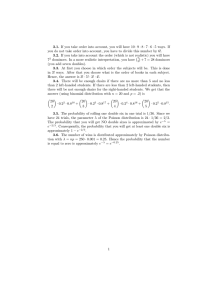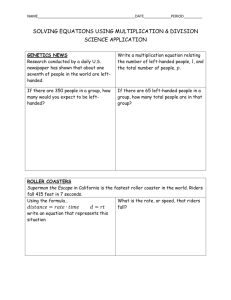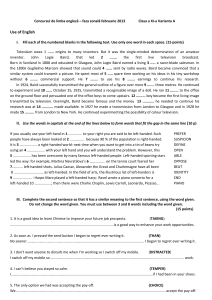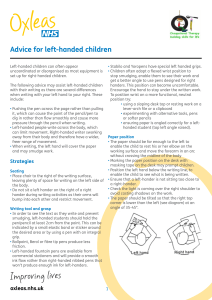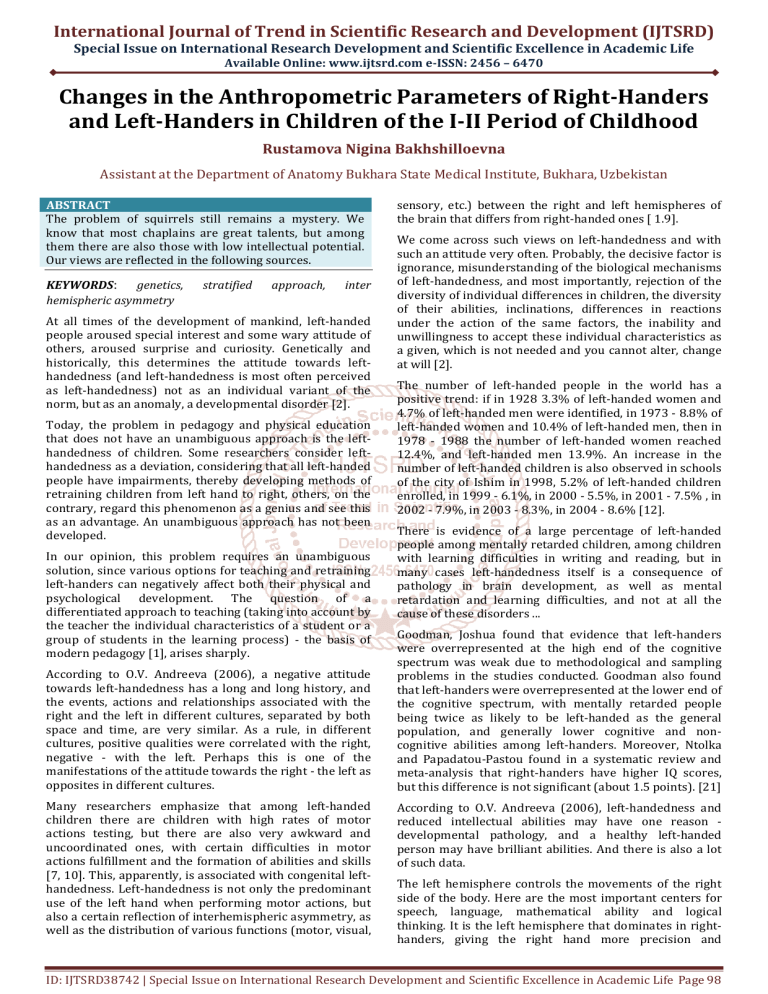
International Journal of Trend in Scientific Research and Development (IJTSRD)
Special Issue on International Research Development and Scientific Excellence in Academic Life
Available Online: www.ijtsrd.com e-ISSN: 2456 – 6470
Changes in the Anthropometric Parameters of Right-Handers
and Left-Handers in Children of the I-II Period of Childhood
Rustamova Nigina Bakhshilloevna
Assistant at the Department of Anatomy Bukhara State Medical Institute, Bukhara, Uzbekistan
ABSTRACT
The problem of squirrels still remains a mystery. We
know that most chaplains are great talents, but among
them there are also those with low intellectual potential.
Our views are reflected in the following sources.
KEYWORDS:
genetics,
hemispheric asymmetry
stratified
approach,
inter
At all times of the development of mankind, left-handed
people aroused special interest and some wary attitude of
others, aroused surprise and curiosity. Genetically and
historically, this determines the attitude towards lefthandedness (and left-handedness is most often perceived
as left-handedness) not as an individual variant of the
norm, but as an anomaly, a developmental disorder [2].
Today, the problem in pedagogy and physical education
that does not have an unambiguous approach is the lefthandedness of children. Some researchers consider lefthandedness as a deviation, considering that all left-handed
people have impairments, thereby developing methods of
retraining children from left hand to right, others, on the
contrary, regard this phenomenon as a genius and see this
as an advantage. An unambiguous approach has not been
developed.
In our opinion, this problem requires an unambiguous
solution, since various options for teaching and retraining
left-handers can negatively affect both their physical and
psychological development. The question of a
differentiated approach to teaching (taking into account by
the teacher the individual characteristics of a student or a
group of students in the learning process) - the basis of
modern pedagogy [1], arises sharply.
According to O.V. Andreeva (2006), a negative attitude
towards left-handedness has a long and long history, and
the events, actions and relationships associated with the
right and the left in different cultures, separated by both
space and time, are very similar. As a rule, in different
cultures, positive qualities were correlated with the right,
negative - with the left. Perhaps this is one of the
manifestations of the attitude towards the right - the left as
opposites in different cultures.
Many researchers emphasize that among left-handed
children there are children with high rates of motor
actions testing, but there are also very awkward and
uncoordinated ones, with certain difficulties in motor
actions fulfillment and the formation of abilities and skills
[7, 10]. This, apparently, is associated with congenital lefthandedness. Left-handedness is not only the predominant
use of the left hand when performing motor actions, but
also a certain reflection of interhemispheric asymmetry, as
well as the distribution of various functions (motor, visual,
sensory, etc.) between the right and left hemispheres of
the brain that differs from right-handed ones [ 1.9].
We come across such views on left-handedness and with
such an attitude very often. Probably, the decisive factor is
ignorance, misunderstanding of the biological mechanisms
of left-handedness, and most importantly, rejection of the
diversity of individual differences in children, the diversity
of their abilities, inclinations, differences in reactions
under the action of the same factors, the inability and
unwillingness to accept these individual characteristics as
a given, which is not needed and you cannot alter, change
at will [2].
The number of left-handed people in the world has a
positive trend: if in 1928 3.3% of left-handed women and
4.7% of left-handed men were identified, in 1973 - 8.8% of
left-handed women and 10.4% of left-handed men, then in
1978 - 1988 the number of left-handed women reached
12.4%, and left-handed men 13.9%. An increase in the
number of left-handed children is also observed in schools
of the city of Ishim in 1998, 5.2% of left-handed children
enrolled, in 1999 - 6.1%, in 2000 - 5.5%, in 2001 - 7.5% , in
2002 - 7.9%, in 2003 - 8.3%, in 2004 - 8.6% [12].
There is evidence of a large percentage of left-handed
people among mentally retarded children, among children
with learning difficulties in writing and reading, but in
many cases left-handedness itself is a consequence of
pathology in brain development, as well as mental
retardation and learning difficulties, and not at all the
cause of these disorders ...
Goodman, Joshua found that evidence that left-handers
were overrepresented at the high end of the cognitive
spectrum was weak due to methodological and sampling
problems in the studies conducted. Goodman also found
that left-handers were overrepresented at the lower end of
the cognitive spectrum, with mentally retarded people
being twice as likely to be left-handed as the general
population, and generally lower cognitive and noncognitive abilities among left-handers. Moreover, Ntolka
and Papadatou-Pastou found in a systematic review and
meta-analysis that right-handers have higher IQ scores,
but this difference is not significant (about 1.5 points). [21]
According to O.V. Andreeva (2006), left-handedness and
reduced intellectual abilities may have one reason developmental pathology, and a healthy left-handed
person may have brilliant abilities. And there is also a lot
of such data.
The left hemisphere controls the movements of the right
side of the body. Here are the most important centers for
speech, language, mathematical ability and logical
thinking. It is the left hemisphere that dominates in righthanders, giving the right hand more precision and
ID: IJTSRD38742 | Special Issue on International Research Development and Scientific Excellence in Academic Life Page 98
International Journal of Trend in Scientific Research and Development (IJTSRD) @ www.ijtsrd.com eISSN: 2456-6470
dexterity of movement. The right hemisphere is
responsible for the left side and is the focus of visual
perception, musical aptitude, and abstract thinking. So,
with regard to the educational process, it is necessary to
take into account that the right hemisphere is responsible
for the sensory perception of the world and provides
imaginative thinking, while the left hemisphere is
responsible for logic, speech and abstract thinking [1,8].
Due to the specifics of the functions performed by the
leading left-handed children by the right hemisphere of
the brain, scientists note that they often have disorders or
deficiencies in the development of visual-spatial
perception, visual memory and visual-motor coordination,
which results in difficulties in distinguishing, memorizing
and writing complex configurations of letters of numbers ,
drawing of geometric figures, as well as mirror writing,
pronounced handwriting disorders, tremors, etc. [16].
The level of development of fine motor skills in left-handed
children with developmental pathology and in left-handed
children with forced left-handedness turns out to be
insufficient for mastering writing [3,12].
Left-handedness is a reflection of the hereditary and
mature system of brain functioning. That is why retraining
a left-handed person means seriously changing his biology,
which means risking his physical and psycho-emotional
health.
Left-handedness has generally been associated with an
increase in the incidence of various serious terminal and
mental illness, as well as earlier death.
Weight loss at birth and complications at birth are
positively correlated with left-sidedness. [19]
The special organization of the nervous system, the
distribution of labor between the cerebral hemispheres
constitute a whole complex of human psychological
qualities. It is he who distinguishes left-handers from
right-handers. The difference is not only in what hands
these children write, eat, work with, but also in the
peculiarities of visual perception of information. It has
been established that the visual system of perception is
especially characteristic of left-handed children [10, 20].
In younger schoolchildren, the most common
manifestation of such a deviation in health is asthenic
neurosis. It is accompanied by decreased performance and
activity, increased fatigue, rapid exhaustion. The peak of
activity is observed only in the first two lessons, then in
children there is a decrease in perseverance and motor
disinhibition. After classes, children feel tired, lethargic,
lose interest in receiving new information [1,5].
Due to the contradictory nature of left-handed people in
their psycho-emotional sphere (the need for
communication - shyness, the desire for leadership comfort, the need for high appreciation, praise - low selfregulation of behavior, etc.), many of them experience
difficulties in communication and mutual relations. with
classmates [12].
Homework for left-handed junior schoolchildren is most
often delayed, accompanied by repeated unsuccessful
actions, shouting, crying, distraction, outbursts of
discontent, hysteria, refusal to work, which ultimately lead
to an unsatisfactory result [9,10].
All this creates the basis for the development of fears of
failure, censure of adults and teachers. Moreover, the
desire to overcome these fears of left-handers does not
develop in themselves, regarding this as the norm. It is
believed that this condition is short-lived and should pass
by itself by the end of the first year of schooling, and here
it is important, first of all, for parents and the teacher to
control so that the child does not undergo new emotional
stress. In the opposite development of events, “new” fears
appear: fear of the dark, fear of being alone in a room, and
even fear of death [1,20].
Yet concern for the health and development of left-handed
children is not without foundation. Among left-handed
people, there is a significant proportion of children born as
a result of pregnancy and childbirth, proceeding with
various complications, a high proportion of children with
disorders in the development of the central nervous
system, with a predisposition to neuroses, and decreased
body resistance. Some researchers believe that a lefthanded child may be characterized by asynchronous
development of some mental functions, high emotionality,
some lag in the development of psychomotor functions
and spatial perception [2].
Refusal of retraining, true attention and respect for lefthanded children will reduce the negative impact of
dextrastress on health and personality formation, and
reduce the risk of physical and mental health disorders.
The fact that left-handers are more susceptible to certain
diseases is true. But the propensity to get sick and the
disease are different things, and therefore it is often
possible to prevent illness, knowing the peculiarities of the
mental makeup of left-handers [3].
The idea that in the process of physical education and
sports training it is unacceptable to retrain children with
congenital left-handedness to the right side is more and
more weighty. By forcing a left-hander to work in a lesson
or training with his right hand, we are trying to change not
only the nature of the preference for the working side of
the body and the leading hand, but also at the same time
alter his innate preferences, his biological nature. Along
with this, a negative influence is also reflected in the
retraining of "left-footed" children, which leads to
impaired motor functions, to a change in the process of
physical growth and development. This leads to the
conclusion that imposed uncharacteristic (forced or
retrained) motor asymmetry, regardless of the part of the
human body, has a negative effect [1].
Although physiologists have explained the phenomenon of
left-handedness, there is still no sufficiently fully
developed methodology for teaching left-handed firstgraders to write skills, the methodology for the formation
of general working skills and communication skills has not
been sufficiently developed. The lack of targeted
pedagogical assistance in overcoming the difficulties that
arise when left-handed people enter a new collective
against the background of their conflicting emotional and
psychological characteristics provokes outsiderism in
them [12].
Lefties are united by increased irritability, fatigue, and
emotional vulnerability. Of course, a vulnerable person is
more sensitive to any offense, and sometimes something
that would leave another completely indifferent can offend
him for a long time, and the offense, in turn, provokes a
ID: IJTSRD38742 | Special Issue on International Research Development and Scientific Excellence in Academic Life Page 99
International Journal of Trend in Scientific Research and Development (IJTSRD) @ www.ijtsrd.com eISSN: 2456-6470
(rRST), handedness and indecision. Pers. Individ.
Differ. 55 312–316 10.1016/j.paid.2010.07.021
[CrossRef] [Google Scholar]
stressful situation. But this is redeemed by a more subtle
perception of the world, the ability to see in it that which is
inaccessible to others [2].
The analysis of the available literature showed that the
anthropometric parameters of this or that area of the body
parts were not studied before the end, separately and in
the complex of children - "left-handed". There is also no
data on the morphometric parameters of the body parts of
left-handed children in terms of age and taking into
account sexual demorphism. All this requires a deep study
of this problem and analysis of the data obtained in the
future.
References:
[1] Akimova E. Yu. Development of students' mental
activity in various systems of primary education:
abstract dis. ... candidate of psychological sciences:
19.00.07 / Yaroslav. state ped. un-t them. K. D.
Ushinsky. - Yaroslavl, 2002 .-- 26 p.
[2]
Andreeva O. V. Features of the emotional sphere of
left-handed children of senior preschool age: dis.
candidate of psychological sciences: 19.00.01 General psychology, personality psychology, history
of psychology. Ekaterinburg. 2006.164 p.
[10]
Harvard Gazette "A lefty's lament".. 2015-01-30.
Archived from the original on 2015-12-23.
Retrieved 2015-12-29.
[11]
Joy Clark. Human organism. // Scientific and
educational collection Tree of Knowledge. No. 33 M
.: MS IST LIMI-TED, 2001.
[12]
Massanova A. A. Development of physical qualities
of a preschooler. // Experiment and innovation in
school. 2011. No. 1. S. 64-68.
[13]
Nikolaeva E.I. Left-handed child: diagnosis, training,
correction. SPb .: "DETSTVO-PRESS", 2005.128 p.
[14]
Ntolka, Eleni; Papadatou-Pastou, Marietta (2018).
"Right-handers have negligibly higher IQ scores
than left-handers: Systematic review and metaanalyses". Neuroscience and Biobehavioral Reviews.
84: 376–393. doi:10.1016/j.neubiorev.2017.08.007.
PMID 28826694.
[15]
Osokina T. I. Physical culture and sports equipment
for preschool educational institutions / T.I. Osokina,
E.A. Timofeeva, M.A. Runova. M .: MOSAIKA-SINTEZ,
1999 .-- 80 p.
[3]
Beley N. Ya. Methodical recommendations for
teaching left-handed children in physical education
class. M., 2012.
[16]
[4]
Beratis I. N., Rabavilas A. D., Papadimitriou G. N.,
Papageorgiou C. (2011). Eysenck’s model of
personality and psychopathological components in
right- and left-handers. Pers. Individ. Differ. 50
1267–1272 10.1016/j.paid.2010.10.033 [CrossRef]
[Google Scholar]
Savkina N. G. Dissertation on the topic: Pedagogical
assistance to left-handed children in the first year of
their schooling. Tyumen, 2005.266 p.
[17]
Semenovich A. V. Neuropsychological correction in
childhood. The method of replacement ontogenesis:
textbook / A. V. Semenovich. M .: Genesis, 2007 .-474 p.
[5]
Bezrukikh M. M. Difficulties of
elementary school. M., 2008, 350s.
[18]
[6]
Glazyrina L. D. Physical culture - for preschoolers.
Older age / L. D. Glazyrina. M .: VLADOS, 2000 .-264 p.
Sidenko A. S., Yashina GA Review of early childhood
development techniques. // Experiment and
innovation in school. 2013. No. 6.S.31-38.
[19]
Tagiltseva N. G. Development of creative activity of
children and youth: kindergarten, school, university.
// Innovative projects and programs in education.
2012. No. 2. P.42-46.
[20]
Tarakanova V. V. Gender characteristics of the
development of cognitive processes in preschool
age. // Experiment and innovation in school. 2013.
No. 6.S.41-44.
[21]
Trofimovskaya O. V. Shkolnik in an innovative
environment. // Experiment and innovation in
school. 2012. No. 1. P.23-28.
[7]
[8]
[9]
learning
in
Goodman, Joshua (Fall 2014). "The Wages of
Sinistrality: Handedness, Brain Structure, and
Human Capital Accumulation". Journal of Economic
Perspectives.
28
(4):
193–212.
doi:10.1257/jep.28.4.193.
Guriev S. V. Using a computer in the process of
physical education of senior preschool children //
Innovative projects and programs in education
2013. No. 5.P.52-58.
Hardie S. M., Wright L. (2013). The relationship
between Revised Reinforcement Sensitivity Theory
ID: IJTSRD38742 | Special Issue on International Research Development and Scientific Excellence in Academic LifePage 100



